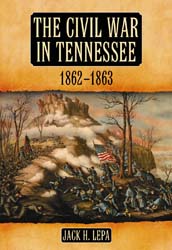 The Civil War in Tennessee, 1862-1863, by Jack H. Lepa
The Civil War in Tennessee, 1862-1863, by Jack H. Lepa
McFarland
ISBN 978-0-7864-2978-3
photos, notes, bibliography, index
239pp. hardcover (7 x 10) 2007
$45
You type in “Civil War Virginia” in google.com and you get a return of 35,800, however, change the Virginia to “Tennessee” and you get less than a thousand. The Eastern Theater has always received the most attention. It saw lots of battles. Virginia alone saw 128, the most by far of any state. (Tennessee is second with 38). The largest armies fought in some of the most desperate battles in the east. But does that alone make it the most important region of the conflict and the place where the war was decided? No, clearly not. Though the Western Theater does not get the attention it deserves, it clearly was the most important region and its demise had the largest single impact on the war. With that in mind, Tennessee is at the heart of that region, and the fighting that took place there saved the Union.
All one has to do is look at a map. If you visualize the United States at that time as a body, Tennessee is the heart. The most important rivers and railroads, for not just transportation but future recruits, fall within Tennessee at some point. The Tennessee/Georgia Railroad, Memphis/Charleston Railroad, Nashville/Chattanooga Railroad, and lets not forget about the rivers: Mississippi, Tennessee, and Cumberland; all provided vital lifeblood (the main blood vessel) for the Confederacy.
Jack H. Lepa’s book is an excellent study detailing the key battles and events in the struggle for control of Tennessee during 1862 and 1863, one that the Federal army would ultimately win, but not because the South or North was better at understanding the value of the region. Controlling the rivers, railroads and mountain trails was key for the Union as it changed its strategy by 1864. The Federal army got lucky in that it simply had the better generals, and the better equipped and trained army in Tennessee.
The book was well written and seemed in-depth enough, though at 232 pages including the index it felt a little light sometimes and could have used more detail. Lepa does draw from contemporary sources such as memoirs and official correspondence. Maps were few and far between and not of quality.
Jack H. Lepa is also the author of “Breaking the Confederacy” (2005) and “The Shenandoah Valley Campaign in 1864″ (2003).